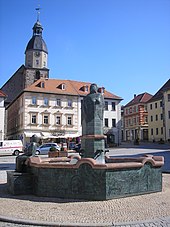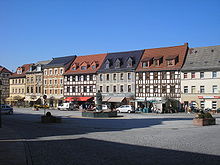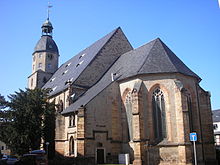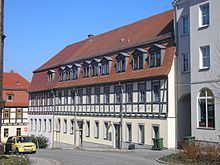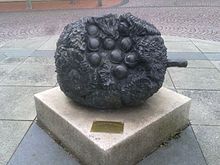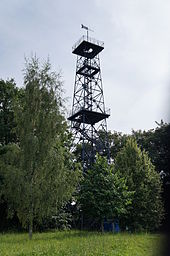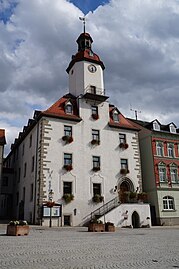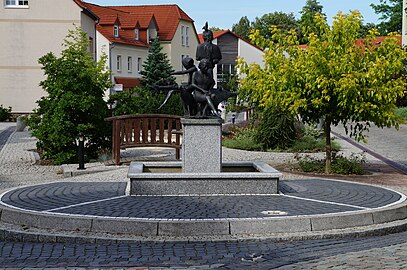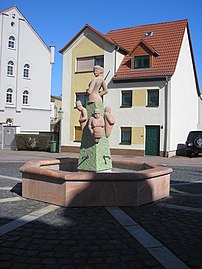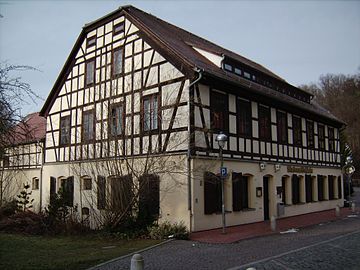Schmoelln
| coat of arms | Germany map | |
|---|---|---|
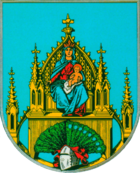
|
Coordinates: 50 ° 54 ' N , 12 ° 21' E |
|
| Basic data | ||
| State : | Thuringia | |
| County : | Altenburger Land | |
| Fulfilling municipality : | for Dobitschen | |
| Height : | 220 m above sea level NHN | |
| Area : | 94.72 km 2 | |
| Residents: | 13,724 (Dec. 31, 2019) | |
| Population density : | 145 inhabitants per km 2 | |
| Postal code : | 04626 | |
| Area code : | 034491 | |
| License plate : | ABG, SLN | |
| Community key : | 16 0 77 043 | |
| LOCODE : | DE CML | |
| City structure: | Core city, 44 districts , of which 5 districts with district constitution |
|
City administration address : |
Markt 1 04626 Schmölln |
|
| Website : | ||
| Mayor : | Sven Schrade ( SPD ) | |
| Location of the town of Schmölln in the Altenburger Land district | ||
Schmölln is a city in the Thuringian district of Altenburger Land and is located on the Sprotte . It became known primarily through the button industry in the 19th century.
geography
Geographical location
The foothills of the Ronneburg arable and mining area are located in the southwestern city area around Selka and Weißbach. The city itself lies in the valley of the sprat . The highest point of Schmölln is the Schafberg in Sommeritz at 293 m above sea level. NN .
Neighboring communities
| Reichstädt , Schnaudertal , Starkenberg | Dobitschen , Göllnitz , Göhren | Altenburg |
| Löbichau |

|
Nobitz , Goessnitz |
| Vollmershain , Posterstein | Thonhausen | Heyersdorf , Ponitz |
City structure
Core city
In addition to the core city, Schmölln also includes the following 44 districts, which are listed below according to their incorporation dates:
| Incorporation date | places |
|---|---|
| October 1, 1922 | Nitzschka |
| October 1, 1922 | Summer seat |
| October 1, 1922 | Zschernitzsch |
| July 1, 1950 | Bohra |
| July 1, 1950 | Grief |
| 1st January 1974 |
Nödenitzsch Castle |
| March 8, 1994 |
Weißbach Brandrübel Selka |
| January 1, 1996 |
Großstöbnitz Kleinmückern paper mill |
| 1st January 2019 |
Altkirchen Gimmel Gödissa Göldschen Großtauschwitz Illsitz Jauern Kleintauschwitz Kratschütz Nöbden Platschütz Röthenitz Trebula |
| 1st January 2019 |
Drugs Mohlis |
| 1st January 2019 |
Lumpzig Braunshain Großbraunshain Hartha Kleintauscha Prehna |
| 1st January 2019 |
Nöbdenitz Burkersdorf Lohma Untschen Zagkwitz |
| 1st January 2019 |
Wildenbörten Dobra Graicha Hartroda Kakau |
history
In today's Bohra near Schmölln there was a larger settlement in the Bronze Age. It was found in 2008 and archaeologically evaluated. Slavic settlement in the Schmölln area has been documented since the 7th century.
middle Ages
The name abbatia zmulna was first mentioned in a document in 1066 , when the Benedictine monastery , which was already in existence at that time , was transferred to the diocese of Naumburg with market, coin and customs rights . It is believed that the name is derived from the Sorbian smola for pitch, tar and thus refers to the pitch boiling with pine wood in Schmöllner's early days. According to a forged document from the Pforta monastery (today Schulpforta), Bruno, the “Count in Pleißen”, is said to have initiated the construction of a second monastery on the Pfefferberg belonging to the Cistercian order . This was moved to Pforta in 1138/40 . Its existing Marienkirche gained importance as a German Marian pilgrimage site from the 13th to the 16th century . The Marienkirche "Our Lady on the Mountain" was destroyed in the Peasants' War in 1525 , and the Reformation was introduced four years later .
Presumably in the Carolingian period , the ring wall system in the northeast of the city in a favorable location above the Sprottetal was built. It secured the Sprottefurt on the salt road leading south from Halle via Pegau and Altengroitzsch . Since Thakolf, the Margrave of the Sorbian Mark, gave away property in the neighboring Saara to the Fulda Monastery in 848 , he could also be considered as the initiator of this facility. In 1847 wall remains, iron and bone tools and human skeletal parts were found. The remains of the wall indicate that it was used until the High Middle Ages.
Schmölln received town charter between 1324 and 1329. At that time the monastery and the lands were under Heinrich Reuss von Plauen . Under the governors of Weida, Gera and Plauen , known as "the Reussians ", a feudal castle, a defiant moated castle and a city wall were built in Schmölln . This eight-meter-high circular wall, which is still partially visible today, enclosed the town church , the market and the entire medieval town. Since the governors lost their influence in the 14th century, Schmölln fell to the Wettins for the first time from 1398 to 1410 and then finally in 1419 .
Modern times
Schmölln often changed its administrative affiliation over the centuries. Due to the division of Leipzig in 1485, the city in the Wettin office of Altenburg was added to the Ernestine Electorate of Saxony , which became Albertine after the Wittenberg surrender in 1547 . Through the Naumburg Treaty , the town of Schmölln with the Altenburg office was returned to the Ernestines in 1554/57. In the following years it belonged to these Ernestine duchies : Duchy of Saxony (1554 to 1572), Duchy of Saxony-Weimar (1572 to 1603), Duchy of Saxony-Altenburg (1603 to 1672), Duchy of Saxony-Gotha-Altenburg (1672 to 1826).
With the reorganization of the Ernestine Duchies in 1826, the city came to the newly founded Duchy of Saxony-Altenburg, where it remained until 1918. After the administrative reform in the Duchy, Schmölln belonged to the Eastern District (until 1900) and to the Ronneburg District Office (from 1900).
From 1918 to 1920 Schmölln then belonged to the Free State of Saxony-Altenburg before it was absorbed into the newly formed state of Thuringia . In 1922 Schmölln was incorporated into the Altenburg district.
In 1484 the lower and higher courts were left to the council, attested to at the beginning of the 15th century, and since 1698 a ducal mayor exercised full city administration.
During the Thirty Years' War the people of Schmölln saw several raids by Swedish and imperial troops in 1630/31 and 1632 . The mercenaries plundered the houses of the local residents in order to get food and equipment, including for the upcoming battle of Lützen . In this already tense and deprived situation, the suffering of the people was intensified by the outbreak of a plague epidemic in 1633.
A turning point in the city's history is the devastating city fire of October 19, 1772, in which a large part of the former city (228 houses, approx. 70 barns and other city buildings, including the town hall) was destroyed within 12 hours. Presumably arson in a barn on today's Goetheplatz was the cause of the fire. The “Brandstrasse” below the market still refers to the event that otherwise left hardly any traces, as the building fabric that can be found today - including many half-timbered buildings - was erected as a result. The city church of Sankt Nicolai , built in the 15th century, was also largely destroyed in the great city fire. Only the south-facing part of the building, which contained the city archive, remained intact thanks to the deletion efforts. After the fire, the building was rebuilt in its current form as a three-nave, late-Gothic hall church with a modified tower.
In 1813, Schmölln was in the deployment area of the Battle of the Nations near Leipzig . As a result, numerous troops were quartered in and around the city and Schmölln became a hospital location .
Age of industrialization
Cloth makers, fabric and linen weavers predominated in the city's economy, but Schmölln was only able to develop slowly within the "ban mile" of Altenburg. The brush production has been in operation since 1830 .
In 1849 the notary Otto Heinrich Hase , who was born in Altenburg, became mayor of Schmöllns, who held this office until his death in 1884. With a service period of over 34 years, he was the longest incumbent mayor to date. Thanks to his ambitious commitment, Schmölln experienced a brilliant rise from a rural town shattered by city fire and the Napoleonic wars to an up-and-coming industrial town . So he tried to establish a modern infrastructure as well as the settlement of industrial companies. The municipal savings bank was founded in 1850. In 1863 the Altkirchen entrepreneur Hermann Donath registered his trade as a button maker and thus founded the Schmöllner button industry. At first he produced mother-of-pearl buttons . His brother Valentin Donath found a perfect raw material in the seeds of the fruits of coronet palms , which was very hard and, above all, cheap, since until then it was only used as ballast in ships from South America. That is why the Donath brothers began producing the almost indestructible corozo buttons in their new factory in 1867. This was facilitated by the fact that Schmölln received a rail connection to Gera in the west and to Gößnitz in the east in 1865, which enabled the optimal transport of raw materials and buttons. After all, around 1900 100,000 quintals of stone nuts were imported and around three million buttons were made. By the turn of the century, 29 button factories had been built in the “button city”. In addition, the Association of Coronet Manufacturers was founded in Schmölln in 1895 and the Association of Entrepreneurs Producing Horn Buttons was also based in Schmölln until the First World War. 1500 people worked in button factories around 1900. In addition, women and many children worked at home sewing buttons on cardboard boxes or “cleaning” buttons. In this way, about a third of the city's population was employed in the button industry.
The button industry brought a phenomenal economic boom for the city and attracted many other industrial establishments such as spinning mills, textile and leather processing, mechanical engineering, and cigar and cardboard factories. Toys, jewelry, watch cases and fountain pens were also manufactured. In the second half of the 19th century, Schmölln became the town with the largest number of factory chimneys in the Duchy of Saxony-Altenburg. The number of inhabitants rose rapidly from 4200 between 1860 and 1900: Schmölln became the second largest city in the duchy in 1900 with 10,691 registered inhabitants.
With the economic rise, Mayor Hase also paved the way for modern facilities to move into Schmölln. In 1866, the city gas station was put into operation and in 1873 the city received a functioning fire extinguishing system. In addition, numerous tree plantings for urban greening were initiated under Hase. As a result, the first Schmöllner received electricity from 1898. In 1900 the city hospital opened with 32 beds. With the Realschule Schmölln a secondary educational institution was added in 1902. In 1906 the city baths and in 1912 a Catholic church on Lindenberg were inaugurated. The increased prosperity of Schmölln was given additional expression with the construction of the town's landmark, the iron Ernst Agnes Tower on the Pfefferberg, which was completed in 1893 , as well as with the landing of the airship "Sachsen" in 1913 in the town.
time of the nationalsocialism
With a letter from the Saxon Justice Minister Otto Thierack of July 31, 1933, Alwin Engelhardt (1875–1940), who lived in Schmölln , was employed as a Saxon executioner "until further notice" . The execution of each death sentence was remunerated with 350 Reichsmarks , in the case of several simultaneous executions - foresight - each additional one with 150 Reichsmarks. The Schmöllner address book from 1910 named Engelhardt as managing director of the covering shop on Kemnitzgrund.
The communist resistance fighter Alfred Nitzsche from Schmölln was killed in prison in Ludwigsburg in October 1944 after five years in prison . Alfred-Nitzsche-Strasse is a reminder of him. During the Second World War , more than 300 forced laborers who had to work for armaments were accommodated in the “Deutscher Kaiser” hotel and in the “Mehlhorn & Sohn” steam brickworks.
On April 13, 1945 the citizens of Schmoelln handed the city over to an advance command of the 76th US Infantry Division and the 6th Armored Division. These served as occupation troops in Schmölln until July 1, 1945. A memorial stone reminds of this today.
In July 1945, the Americans handed the occupation over to the Soviet armed forces .
post war period
There was a castle of the von Thümmler family in Selka . The owners were expropriated without compensation in 1945, the refugees who had been quartered since 1944 were expelled from the building and the castle was blown up in 1948 . The basis was order 209 of the SMAD . Only the church and an inconspicuous side wing remained.
The administrative reform in 1952 meant that Schmölln was separated from the territory of the dissolved state of Thuringia and added to the Leipzig district. Schmölln became the seat of the district of the same name.
On June 17, 1953 , the workers in the large Schmöllner factories stopped working and showed their unwillingness with a large demonstration in front of the town hall, which was disbanded by the Soviet Army. The production structure changed due to the new framework conditions in the GDR. The plastic processing industry emerged from the button industry, which, in addition to mechanical engineering and shoe manufacture, developed into the largest branches of the so-called state- owned industry .
As a result of the huge influx of refugees from World War II, the housing shortage became increasingly precarious. In order to cope with the shortage of living space, numerous multi-family houses were built in the newly created "Robert Koch District" as part of a housing program from 1952 to 1968. Since the housing shortage was still problematic and worsened again in the 1980s, the prefabricated building area "Heimstätte" in the south of the city was developed from 1988–1991 . Originally it was primarily intended for families of miners involved in uranium ore mining by the Wismut near Ronneburg , in whose catchment area the city was located.
In 1990 the city went back to the state of Thuringia together with the Schmölln district . Through the administrative reform of 1994 Schmölln lost the status of a district town and merged with the Altenburg district into the new Altenburger Land district . In the spatial planning of Thuringia, Schmölln currently has the status of medium-sized center with Gößnitz . The city has experienced quite positive development since the fall of the Wall . Several commercial areas ( Nitzschka , Kemnitzgrund, Ronneburger Straße) were created on the outskirts , while the city center was able to maintain a high shopping culture, since supermarkets, unlike in Crimmitschau or Meerane , for example , were not placed on the green meadow . The settlement of new companies such as the auto supplier industry in the newly created industrial areas on Crimmitschauer Straße and in Nitzschka was favored by the opening of the A 4 motorway junction 61 Schmölln . The infrastructure of the city improved enormously through two major road construction works. The streets Coßwitzanger and Bachstraße were completely rebuilt as a railway underpass.
Population development
In 1831 there were 3467 inhabitants in Schmölln. By 1910 the population rose to 11,345. The highest population number was reached at the end of the Second World War. In 2019, the population of Schmölln increased significantly due to the incorporation of five surrounding communities.
Development of the population (from 1960: December 31) :

|
| 1925 to 1984 |
1994 to 2003
|
2004 to 2011
|
2012 to 2019
|
Data source from 1994: Thuringian State Office for Statistics
Development of the population by age group:
| Age structure of the Schmölln population in 2000 and 2015 | ||||
|---|---|---|---|---|
| Population aged | year | proportion of | change | |
| under 6 | 2000 | 3.9% | + 0.6% p | |
| 2015 | 4.5% | |||
| 6-15 | 2000 | 8.7% | -2.6% p | |
| 2015 | 6.1% | |||
| 15-65 | 2000 | 67.6% | -4.8% p | |
| 2015 | 62.8% | |||
| over 65 | 2000 | 19.8% | + 5.7% p | |
| 2015 | 25.5% | |||
| Data source: Thuringian State Office for Statistics | ||||
politics
City council
The city council of Schmölln consists of 30 councilors.
| Free electoral association | CDU | Citizens for Schmölln | LEFT | SPD | New forum | FDP | total | |
| 2019 | 6th | 6th | 5 | 5 | 5 | 2 | 1 | 30 seats |
| 2014 | - | 7th | 3 | 5 | 4th | 4th | 1 | 24 seats |
Status: Local elections on May 26, 2019
mayor
Sven Schrade (SPD), born in 1984, has been the mayor since taking office on September 3, 2015. He was a candidate for the 2009 election, but was defeated by the successor of Herbert Köhler (non-party), Kathrin Lorenz (CDU), who held the office of mayor for more than four terms. In the election on June 28, 2015, Sven Schrade prevailed against Kathrin Lorenz (CDU) and Gunther Kupfer (citizens for Schmölln) with 53.6% of the vote and a turnout of 58.2% in the first ballot.
coat of arms
Blazon : “In blue under a golden Gothic canopy adorned with pinnacles and crabs, the golden crowned Maria in red robe and blue cloak with the naked Jesus boy on her lap; underneath a pot helmet, decorated with green peacock feathers, smooth at the front, mirrored at the back. "
The coat of arms comes from the oldest town seal from 1396, which shows the same picture and bears the inscription SIGILLVM CIVIVM IN SMOLN. It represents the patron saint of the oldest church in Schmölln. The peacock feather helmet is the symbol of the Russians who ruled over Schmölln as bailiffs of Gera, Weida and Plauen.
Town twinning
- Žďár nad Sázavou , Czech Republic
- Dobele , Latvia
- Mühlacker , Baden-Württemberg ; On September 3, 2016, at the 950th anniversary of the city of Schmölln, the official partnership was agreed after the two cities had been friends for many years.
Culture and sights
Buildings
The old town is particularly worth seeing in Schmölln. The extensive medieval market with the town hall and the view of the town church is very lively all year round, as numerous shops such as Kaufland can be found in renovated historic buildings. Long opening times also favor this. The cemetery chapel is also worth seeing , it was the former hospital church . Many half-timbered houses are also arranged around the late Gothic town church. Furthermore, part of the city wall with an accessible tower can be visited.
One example of the industrial development in Schmölln in the 19th century is the button industry. Buttons were first made in 1863. From the Ernst Agnes Tower , which was built on the Pfefferberg in 1893, there is a good view of the surrounding area and of the former factory as well as the button and regional museum, which opened in 1997 and is located directly on the idyllic city park. A branch of the museum is located in another industrial plant not far from the main building.
For a complete overview of listed buildings in the city, see the list of cultural monuments in Schmölln .
- Buildings
Sports
Since 1999, the “Around Schmölln” stage of the International Women's Tour of Thuringia and the “Jedermann Race”, which is unique on the tour and which amateurs are allowed to take part, have taken place every year.
Culinary specialties
A well-known specialty in the area between Schmölln and Altenburg is Mutzbraten , usually served with bread and sauerkraut . It is prepared over birch wood.
In the 1960s and 1970s, a common type of food for children in restaurants was the food combination “Ä Sießchen and Ä Blondchen”. It's a small Viennese sausage and a yellow lemonade. The term “Sießchen” can be derived from the English “sausage”. Another approach is the reference to the sausage size, which can be described as "sweet" (cute). The Schmöllner dialect then made "Sießchen" out of it. The derivation of the "blonde" is probably due solely to the color of the drink.
Economy and Infrastructure
Free WiFi has been available in downtown Schmöllner since May 2016 .
traffic
Schmölln is on the A 4 (junction 61: Schmölln) and the B 7 (Gera-Altenburg). On the Gößnitz – Gera railway line there is a train station in Schmölln, which is served by the Regional Express Glauchau - Erfurt - Göttingen and the Regional Express on the Altenburg – Erfurt route . Since the discontinuation of the regional trains in December 2008, the stop in the district of Großstöbnitz has been served early in the morning and late in the evening, but is no longer served at all. There are also several regional connections to Altenburg, Dobitschen, Thonhausen, Gera, Großstechau and Dobra. On weekends only buses go to Altenburg.
Schmölln also has a city bus line with the designation R , which runs in the direction of Blumenstrasse via Markt, Förderzentrum, and continues in the direction of Ahornring / Bahnhof. Schmölln's city bus runs once an hour from Monday to Friday. The city bus does not run on weekends and public holidays. The bus traffic is operated by THÜSAC, the rail traffic by DB Region Süd-Ost.
Established businesses
As in most cities in East Thuringia and West Saxony, the economic structure of Schmölln was strongly influenced by the textile industry. In the button factory introduced in 1861, half of all workers were employed until the First World War . The brush and toothbrush production as well as mechanical engineering developed accordingly .
Machine tool manufacturing (VEB PWS, VEB KnoHoMa) and the plastics industry (VEB Galfütex) experienced an upswing, especially after the Second World War. After the turnaround of 1990 it was possible to stabilize the industry after large job losses. In addition, numerous new settlements were made in the area of automotive suppliers (Neumayer Tekfor) and the food industry (Burkhardt Feinkostwerke, Wolf Wurstwaren). The traditional areas of mechanical engineering and tool construction (PWS Präzisionswerkzeuge GmbH, HOT Oberflächentechnik, HASCO, Midena) and plastics processing (KTS Kunststofftechnik Schmölln, Markus Birner Kunststofftechnik GmbH) also continue to exist in the city.
From what used to be more than ten button factories there is only one left, the textile industry has also disappeared from Schmölln except for one company. Compared to other locations in the new federal states, Schmölln can look back on a positive economic development, which is also positively noticeable in the cityscape. New industrial sites (industrial area Nitzschka, industrial area Crimmitschauer Straße I, II and III) were developed. Since it was founded in 2002, manufacturing businesses have been settling in the Nitzschka-Nörditz industrial network of the Schmölln-Gößnitz municipal association .
media
- Kabel plus, television for the Schmölln, Meerane, Waldenburg region
- Schmöllner Nachrichten (local edition of the Ostthüringer Zeitung )
Public facilities
The city administration of the city of Schmölln, the branch of the Altenburger Land employment office , the Johanniter rescue station , the Schmölln volunteer fire brigade , the branch of the Altenburger Land clinic , the registry office and the city library should be mentioned. Institutions and corporations are the outdoor and indoor swimming pool “ Tatami ”, which opened in 2006 , the regional and button museum Schmölln, the multi-purpose hall “Ostthüringenhalle” built in 1993 and the student leisure center (SFZ).
Among the church parishes, the town church of St. Nicolai with a choir, the Catholic parish of St. Maria Immaculata, the New Apostolic parish and the Evangelical Free Church parish, which runs a special youth program, should be mentioned.
education
Educational institutions are the primary school "Finkenweg", the regular school "Am Eichberg", the state Roman-Herzog -Gymnasium Schmölln, the support center and the school part Schmölln of the vocational school center for trade and technology. There are also five day-care centers, the Johann Friedrich Agricola music school , the Altenburger Land adult education center and the city library on the market.
sons and daughters of the town
- Ernst Otto (1891–1941), Protestant pastor, head of the Lutheran Confessional Community of Thuringia (Confessing Church) = "Emergency Bishop" of the Thuringian Protestant Church (1934–1938)
- Herbert Staude (1901–1983), chemistry professor
- Erich Pachnicke (1905–1963), politician (SPD)
- Werner Beyer (1920–1997), trombonist (Sächsische Staatskapelle Dresden)
- Siegfried Ebel (1934–2019), pharmacist and professor of pharmaceutical chemistry at the University of Würzburg
- Horst Bräutigam (* 1937), four times world champion in sport bowling
- Franz Bartzsch (1947–2010), musician
- Engelbert von Nordhausen (* 1948), actor and voice actor
- Michael Buchheim (* 1949), marksman, Olympic knight in skeet shooting in 1972 in Munich
- Lutz Remus (* 1960), wrestler
- Jens König (* 1965), soccer player
- Steven Küchler (* 1975), boxer and boxing trainer
- Caroline Scholze (* 1975), actress
- Theresa Scholze (* 1980), actress
- Katja Demut (* 1983), track and field athlete
- Matthias Plarre (* 1992), racing cyclist
Others
Schmölln is home to the domestic pigeon breed Schmöllner drum pigeon , which has been bred since 1912.
literature
- Karl Höhn: Historical development of the commercial life of the city of Schmölln . Schmölln 1892 ( digitized version ).
- Antje Kuhnt, Wolfgang Bauer: Schmölln. Life in the Sprottetal . Sutton Verlag, Erfurt 2000, ISBN 978-3-89702-262-1 .
- Wolfgang Bauer, Antje Kuhnt: Schmölln. A photo album . Sutton Verlag, Erfurt 2002, ISBN 978-3-89702-431-1 .
- Karin Bauer, Udo Kuhnt: Time leaps in Schmölln . Sutton Verlag, Erfurt 2010, ISBN 978-3-86680-661-0 .
- Heimat- und Beschönerungsverein Schmölln eV: Schmölln through the ages . Sutton Verlag, Erfurt 2013, ISBN 978-3-95400-306-8 .
Web links
Individual evidence
- ^ Population of the municipalities from the Thuringian State Office for Statistics ( help on this ).
- ↑ Lost and Found, No. 263: Bronze Age Settlement. n-tv, January 6, 2008, accessed October 27, 2012 .
- ↑ In his dissertation in 2003, the historian Holger Kunde was able to prove that 13 documents from the Pforta monastery were forgeries from the time of Abbot Widemar.
- ↑ Francis Xavier. Thakolf, in ADB Vol 37, Leipzig 1894, pp 361 et seq.
- ↑ Michael Köhler: Thuringian castles and fortified prehistoric and early historical living spaces. Jenzig-Verlag, 2001, ISBN 3-910141-43-9 , p. 200/201.
- ^ The Altenburg Office in the book "Geography for all Stands", from p. 201
- ^ The locations of the Altenburg district from p.83
- ^ The Naumburg Treaty in the chronicle of the city of Langensalza in Thuringia, pp. 207f.
- ^ The Altenburg Office in the Historical Directory of Saxony
- ↑ The eastern district of the Duchy of Saxony-Altenburg in the municipal directory 1900
- ^ The district office of Ronneburg in the municipality register 1900
- ↑ a b cf .: Otto Hase - A mayor turns a city inside out In: Official Journal of the City of Schmölln , vol. 13, 2009, p. 16, accessed on August 4, 2017
- ↑ a b Button and Regional Museum. City of Schmölln, accessed on August 4, 2017 .
- ↑ On the trail of history. City of Schmölln, accessed on August 3, 2017 .
- ↑ In detail: Blazek, Matthias, Executioner in Prussia and in the German Empire 1866–1945, Stuttgart 2010, ISBN 978-3-8382-0107-8 , p. 57 ff.
- ^ Municipal directory Germany 1900 - Duchy of Saxony-Altenburg - District Office Ronneburg. Retrieved October 27, 2012 .
- ↑ City council elections 2019 in Thuringia - final result. Thuringian State Office for Statistics, accessed on June 6, 2019 .
- ↑ 2014 municipal council elections in Thuringia - final result. Thuringian State Office for Statistics, accessed on June 6, 2019 .
- ↑ a b Description of coat of arms Schmölln, City Administration Schmölln, 1993
- ↑ WiFi for everyone: Free network from now on on the market square in Schmölln , OTZ from May 31, 2016, accessed on June 26, 2016.





